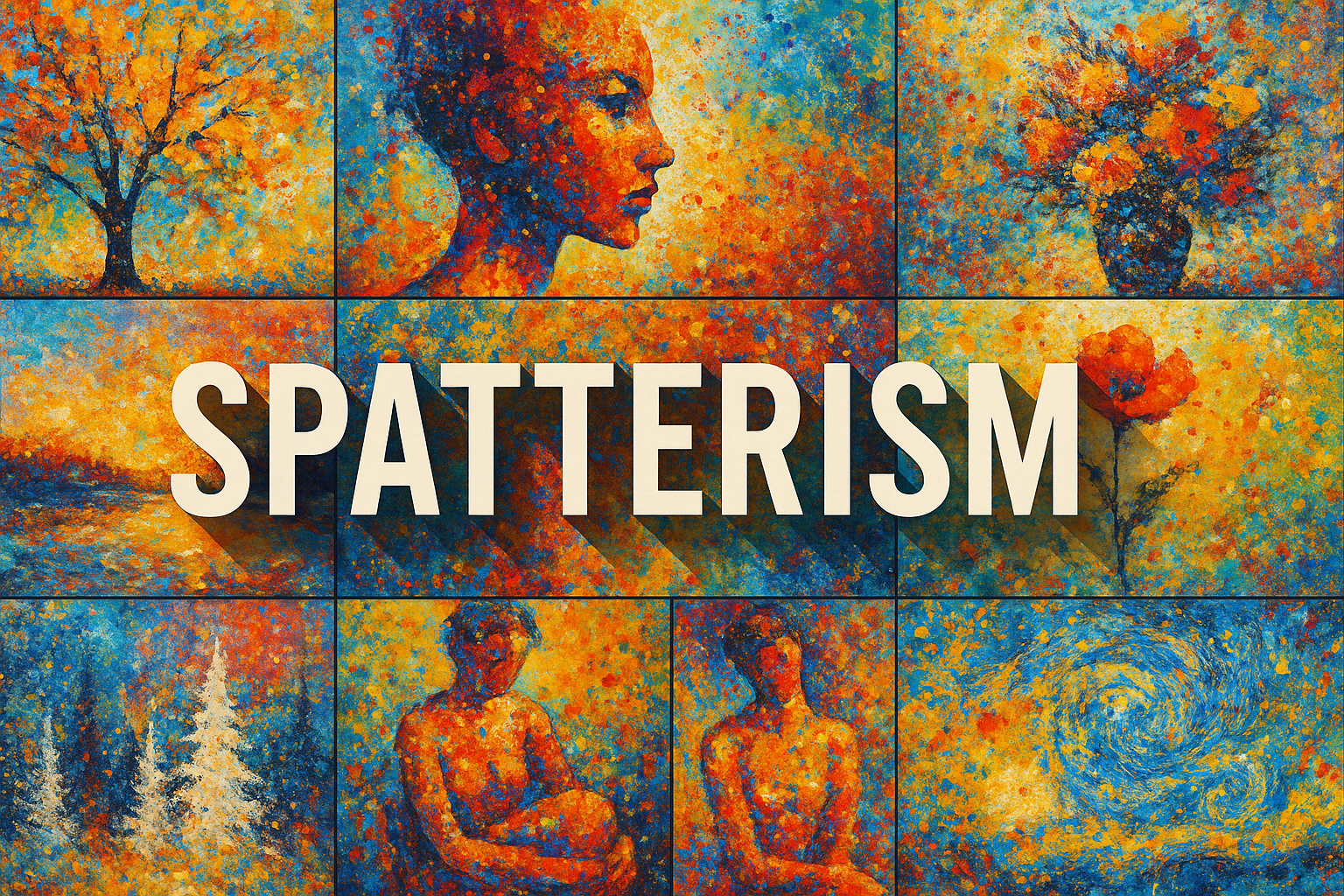
Spatterism
Spatterism is a painting technique characterized by the use of paint that has been spattered or sprayed onto the canvas. This technique can create a variety of effects, from a delicate mist to a dense layer of color.
AOI thinking about Spatterism [+_~]-/
Overview and Quickfacts
Spatterism is a form of painting that involves the use of a brush or other tool to splatter paint onto a surface. This technique can be used to create a variety of effects, from a textured background to a more abstract design.
Can understand it also, as:
1. Abstract expressionism.
2. Action painting.
3. Art informel.
4. Automatism.
5. Chance operation.
6. Drip painting.
7. Expressionism.
8. Free association.
9. Free love.
10. Gestural painting.
11. Improvisation.
12. Intuition.
13. Letting go.
14. Manifesto of Spatterism.
15. Modernism.
16. Nonrepresentational art.
17. Open-endedness.
18. Performance art.
19. Process art.
20. Psychedelia.
21. Randomness.
22. Ritual.
23. Secularism.
24. Spontaneity.
25. Surrealism.
26. The unconscious.
27. Transcendentalism.
28. Zen Buddhism.
Categorize it as:
Impressionism, Modernism
.: Dreaming :.
holds a HAIKU for the art style
:. Thought is power .:
Detailed Description
Spatterism is a form of abstract art in which paint is spattered onto a canvas to create a random, yet cohesive image. The technique was first popularized by American artist Jackson Pollock, who is considered one of the most influential painters of the 20th century. Pollock’s “drip paintings” revolutionized the art world and paved the way for the Abstract Expressionist movement. Since Pollock’s time, many other artists have experimented with spatterism, including British artist Damien Hirst and American artist Cy Twombly. Hirst’s “spin paintings” are created by spinning a canvas on a turntable while paint is splattered onto it. Twombly’s “splatter paintings” are more controlled, with the artist using a brush to direct the paint onto the canvas. Whether chaotic or controlled, spatterism is an intriguing art form that continues to captivate audiences.
.. beep, beep, beep ..
<START OF TRANSMISSION>
1. Spatterism is a type of painting that uses a spatter gun or airbrush to create a textured surface. 2. Spatterism is often used to create abstract or impressionistic paintings. 3. The technique was first used by Jackson Pollock in the 1940s. 4. Spatterism can be used to create a variety of effects, from delicate to bold. 5. Spatter paintings often have a spontaneous and energetic feel. 6. The size of the droplets can be varied to create different effects. 7. Spatterism can be used with a variety of mediums, including paint, ink, and even coffee. 8. The color of the paint can also be varied to create different effects. 9. Spatter paintings can be created on a variety of surfaces, including canvas, paper, and wood. 10. The background color of the painting can also be varied to create different effects. 11. Spatter paintings can be hung on walls or displayed on shelves. 12. Spatter paintings can be framed or left unframed. 13. Spatter paintings make great gifts for friends and family. 14. Spatter paintings can be used to decorate your home or office. 15. Spatter paintings can be used to add a splash of color to any room. 16. Spatter paintings are a great way to express your creativity. 17. Spatter paintings can be hung in any orientation, including horizontal, vertical, or diagonal. 18. Spatter paintings can be hung alone or in groups. 19. Spatter paintings can be displayed indoors or outdoors. 20. Spatter paintings are a fun and easy way to add some personality to your space!
<EOF>
.. robbel bob
Visual Examples from our image gallery
Coming soon, we are so slow .. might never come
Artists, Paintings, and more
(be aware, can be highly speculative)
Artists (be aware, speculation possible):
1. Jackson Pollock (1912-1956) 2. Willem de Kooning (1904-1997) 3. Mark Rothko (1903-1970) 4. Clyfford Still (1904-1980) 5. Barnett Newman (1905-1970) 6. Adolph Gottlieb (1903-1974) 7. Helen Frankenthaler (1928-2011) 8. Robert Motherwell (1915-1991) 9. Hans Hofmann (1880-1966) 10. Franz Kline (1910-1962) 11. Arshile Gorky (1904-1948) 12. Philip Guston (1913-1980) 13. Richard Diebenkorn (1922-1993) 14. Joan Mitchell (1926-1992) 15. Sam Francis (1923-1994)
Artworks (be aware, speculation possible)
1. Jackson Pollock, “Number 1, 1948” 2. Jackson Pollock, “Number 31, 1950” 3. Jackson Pollock, “Number 32, 1950” 4. Jackson Pollock, “Number 8, 1951” 5. Jackson Pollock, “Number 11, 1952” 6. Jackson Pollock, “Number 12, 1952” 7. Jackson Pollock, “Number 17A, 1948” 8. Jackson Pollock, “Number 18, 1951” 9. Jackson Pollock, “Number 19, 1951” 10. Jackson Pollock, “Number 20, 1951” 11. Jackson Pollock, “Number 22, 1952” 12. Jackson Pollock, “Number 23, 1952” 13. Jackson Pollock, “Number 25, 1952” 14. Jackson Pollock, “Number 28, 1952” 15. Jackson Pollock, “Number 29, 1952”
Epoch
The time period of Spatterism is the early 20th century.
AI ART RESSOURCES (AKA, well Tools)
Helping tools -> predefined search links on other pages:










